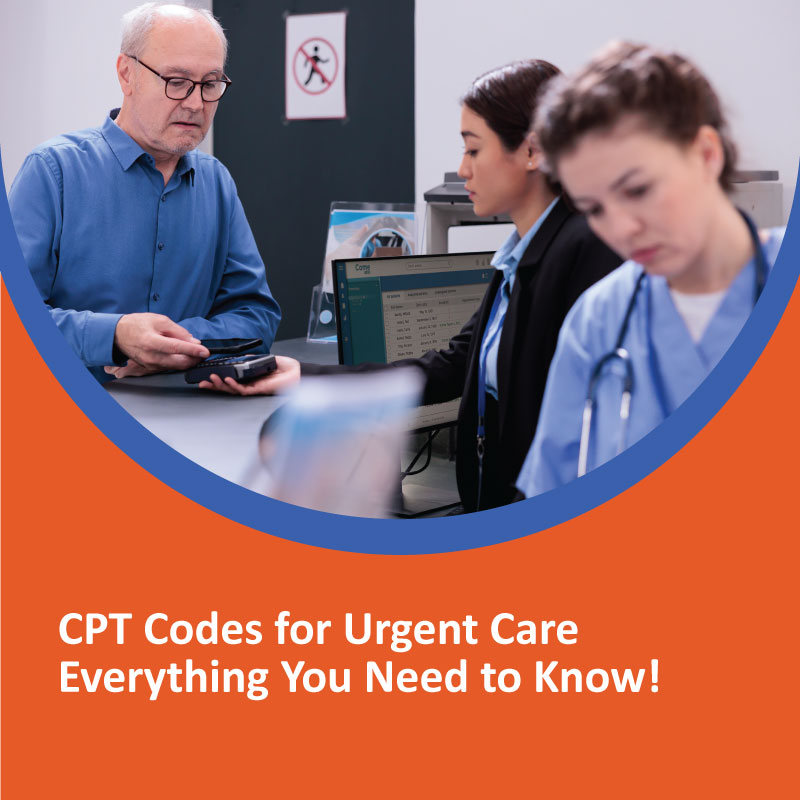Urgent care centers commonly treat harmless illnesses and accidents. They can treat such patients faster than primary care physicians or emergency departments. Given the increasing evolution of this type of service anywhere in the United States, urgent care facilities should follow exact billing and coding procedures and accurately apply CPT codes to receive timely and accurate reimbursement.
Furthermore, the CPT code for urgent care visits is a standard numerical system. It describes medical procedures and services. Private and Medicare insurers have established a reimbursement amount for each code. Accurate CPT classification protects denied underpayment and claims.
Moreover, we have developed a comprehensive guide on everything about Urgent care CPT coding. So, let’s begin!
Understanding CPT Code For Urgent Care Visit
If we talk about the CPT Code for Urgent Care, code is a numerical system used to describe medical procedures and services. These codes are important in urgent care settings. They ensure timely and accurate reimbursement for private and Medicare insurers. Accurate application of these codes is evaluative to avoid denied underpayment and claims.
Moreover, it is essential to understand that CPT codes are updated regularly because of reflection in medical technology. Thus, staying up-to-date with all changes is significant for avoiding potential reimbursement delays, correct billing, and urgent care.
Common or Basic Urgent Care CPT Codes
If we talk about CPT codes for urgent care visits or CPT codes, there are particular codes that are often used to represent the provider of services. The CPT codes include but are not limited to the following:
- 20525-20553: Foreign Body Removal
- 99201-99205: Evaluation & Management of New Patients
- 12001-13160: Wound Repair
- 29000-29799: Splint and Cast Applications
- 10060-10180: Incision & Drainage
- 99211-99215: Evaluation & Management of Established Patients
Exclusive ‘S’ Codes for Urgent Care
Both primary and urgent care have been using codes from HCPCS (Healthcare Common Procedure Coding System). These exclusive codes are denoted with the letter “S,” such as:
S9083:
The S9083 code lets urgent care centers charge one fee for all services, regardless of the patient’s treatment. An MCO (managed care organization) sometimes asks a facility to bill using this code. In certain states, like Florida and Arizona, MCOs require urgent care to bill all services under S9083.
S9088:
The S9088 code lets urgent care centers bill for evaluating and treating medical conditions. It acknowledges that urgent care services often cost more. The code is not used alone; it needs to be billed with an E/M code. This code helps urgent care get paid back for some of the extra costs of providing immediate care.
Best Tips and Practices for Urgent Care Billing Codes
- Use specific billing codes: Use the most accurate and specific billing codes for each service provided. It is to ensure proper reimbursement.
- Stay up-to-date: Keep track of any updates or changes to billing codes issued by relevant authorities. This approach can avoid billing errors and maximize reimbursement.
- Document thoroughly: Ensure detailed documentation of each patient encounter. It includes the services provided and any procedures performed, to support billing claims.
- Understanding Coding Guidelines: Understand the urgent care billing’s specific coding guidelines to ensure compliance and avoid denials.
- Train Staff: Provide training to staff members involved with coding and billing processes. By train them, they understand the importance of accurate coding and documentation.
- Review claims prior to submission: Double-check claims for accuracy and completeness prior to submitting them to reduce the risk of rejections or denials.
- Monitor reimbursement trends to identify any issues or areas for improvement within your billing process.
- Use technology: Consider using billing software or tools for urgent care facilities. It can smooth the billing process and minimize errors.
By following these tips and best practices, urgent care facilities can improve their billing processes. Also, they can maximize reimbursement for services provided.
How Does the Urgent Care Billing Method Work?
Urgent care centers are important in our healthcare system. It is reducing the gap between primary care providers and emergency rooms. That’s why they are getting more popular. To succeed in this competitive market, it’s crucial to grasp billing basics and make smooth workflows for better returns.
Urgent Care Billing Starts at the front desk.
Billing in urgent care starts when patients walk in the door. Effective financial policies from check-in can boost revenues and cut down on costly collection efforts.
Since urgent care usually doesn’t have pre-registration, the front desk staff must gather basic billing info when patients arrive.
They should collect:
- Name, address, birth date, and reason for the visit.
- Insurance company name, primary care provider, and policy number.
Ideally, this information helps create an electronic health record. Providers and staff use the EHR to keep track of patient notes, health history, and treatments. Keeping records updated makes billing smoother. For returning patients, it’s important to note any changes in their information at each visit.
Confirm Financial Responsibilities
Urgent care clinics often can only call insurance companies for pre-authorization after providing services. Patients should know their plan details and understand the costs at a walk-in facility. To prevent billing problems, patients should sign a financial responsibility form before getting medical care.
Post-Visit Follow Ups
After a patient receives services, the provider should note all procedures and essential details in the EHR. This ensures an accurate bill, makes creating the claim easier, and collects any patient balance.
Transforming the Claims
Once each medical procedure is coded and checked for compliance, the final step in billing is to send the claim to the payer. The bill sent to the insurance company includes diagnosis, procedures, and charges. An accurate bill speeds up reimbursement, ensuring timely payment for healthcare providers.
Most practices submit claims electronically, using medical software to record patient info and create reimbursement claims.
Conclusion of CPT Code for Urgent Care
In conclusion, mastery of CPT codes for urgent care is key for accurate reimbursement and smooth financial operations in urgent care centers. These numerical codes serve as a standardized way to describe medical procedures and services. It makes billing accurate and timely reimbursement from both private and Medicare insurers possible. Staying alongside of coding updates is key in order to avoid reimbursement delays or errors.
Implementing specific billing codes, detailed documentation, and staff training are key practices to maximize reimbursements and simplify billing processes. With urgent care becoming a larger part of healthcare systems today, effective billing and coding practices must be adopted quickly in order to provide high-quality care while managing finances efficiently in this rapidly expanding market.



